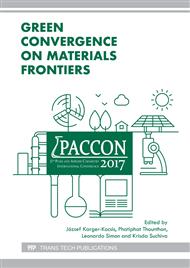[1]
L. Cormier, G. Calas, B. Beuneu, Structural changes between soda-lime silicate glass and melt, J. Non-Cryst. Solids. 357 (2011) 926–931.
DOI: 10.1016/j.jnoncrysol.2010.10.014
Google Scholar
[2]
E. Rafiee, S. Shahebrahimi, Nano Silica with High Surface Area from Rice Husk as a Support for 12-Tungstophosphoric Acid: An Efficient Nano Catalyst in Some Organic Reactions, Chin. J. Catal. 33 (2012) 1326–1333.
DOI: 10.1016/s1872-2067(11)60420-8
Google Scholar
[3]
F.H. Elbatal, M.A. Marzouk, H.A. Elbatal, Optical and crystallization studies of titanium dioxide doped sodium and potassium silicate glasses, J. Mol. Struct. 1121 (2016) 54-59.
DOI: 10.1016/j.molstruc.2016.05.052
Google Scholar
[4]
S. La Delfa, E. Ciliberto, L. Pirri, Behaviour of copper and lead as chromophore elements in sodium silicate glasses, J. Cult. Herit. 9 (2008) 117-122.
DOI: 10.1016/j.culher.2008.07.006
Google Scholar
[5]
R. Arletti, M.C. Dalconi, Roman coloured and opaque glass: a chemical and spectroscopic study, Appl. Phys. A. 83 (2006) 239–245.
DOI: 10.1007/s00339-006-3515-2
Google Scholar
[6]
S. Lee, S. Hwang, M. Cha, Role of copper ion in preventing silver nanoparticles forming in Bi2O3-B2O3-ZnO glass, J. Phys. Chem. Solids. 69 (2008) 1498–1500.
DOI: 10.1016/j.jpcs.2007.10.118
Google Scholar
[7]
F.H. Elbatal, S.Y. Marzouk, N. Nada, S.M. Desouky, Gamma-ray interaction with copper-doped bismuth-borate glasses, Physica. B. 391 (2007) 88–97.
DOI: 10.1016/j.physb.2006.09.001
Google Scholar
[8]
A. Quaranta, R. Ceccato, C. Menato, Formation of copper nanocrystals in alkali-lime silica glass by means of different reducing agents, J. Non-Cryst. Solids. 345 (2004) 671-675.
DOI: 10.1016/j.jnoncrysol.2004.08.160
Google Scholar
[9]
T. Som, B. Karmakar, One-step synthesis and properties of monolithic photoluminescent ruby colored, J. Alloy. Compd. 509 (2011) 4999–5007.
DOI: 10.1016/j.jallcom.2011.01.208
Google Scholar
[10]
B. Ravel and M. Newville, ATHENA, ARTEMIS, HEPHAESTUS: data analysis for X-ray absorption spectroscopy using IFEFFIT, J. Synchrotron. Radiat. 12 (2005) 537–541.
DOI: 10.1107/s0909049505012719
Google Scholar
[11]
W. Mi-tang, C. Jin-shu, Viscosity and thermal expansion of rare earth containing soda-lime silicate glass, J. Alloy. Compd. 504 (2010) 273–276.
DOI: 10.1016/j.jallcom.2010.05.111
Google Scholar
[12]
F.H. Elbatal, E.M.A. Khalil, Infrared reflection spectroscopy for precise tracking of corrosion behavior in 3d-transition metals doped binary lead silicate glass, Physica. B. 405 (2010) 2648–2653.
DOI: 10.1016/j.physb.2010.03.044
Google Scholar
[13]
E.M.A. Khalil, F.H. ElBatal, Y.M. Hamdy, H.M. Zidan, M.S. Aziz, A.M. Abdelghany, Infrared absorption spectra of transition metals-doped soda lime silica glasses, Physica. B. 405 (2010) 1294–1300.
DOI: 10.1016/j.physb.2009.11.070
Google Scholar
[14]
J. Rothe, J. Hormes, In Situ X-ray Absorption Spectroscopy Investigation during the Formation of Colloidal Copper, J. Am. Chem. Soc. 120 (1998) 6019-6023.
DOI: 10.1021/ja972748w
Google Scholar
[15]
S. Daengsakul , P. Kidkhunthod, O. Soisang, T. Kuenoon, A. Bootchanont, S. Maensir, The effect of Gd doping in La1-x-yGdxSryMnO3 compound on nanocrystalline structure by X-ray Absorption Spectroscopy (XAS) technique, Microelectron. Eng. 146 (2015).
DOI: 10.1016/j.mee.2015.03.065
Google Scholar
[16]
J. Kaufmann, C. Russel, Thermodynamics of the Cu+/Cu2+-redox equilibrium in soda-silicate and soda-lime-silicate melts, J. Non-Cryst. Solids. 355 (2009) 531–535.
DOI: 10.1016/j.jnoncrysol.2009.02.004
Google Scholar
[17]
R. Buntem and K. Samkongngam, XANES Studies on the Oxidation States of Copper and Iron in Silicate Glass Matrix, PACCON 2015 proceedings. (2015) 909-912.
DOI: 10.4028/www.scientific.net/kem.757.9
Google Scholar


